Minimalism
What is Minimalism & what does it mean for you?
What is Minimalism & what does it mean for you?
The Americans with Disabilities Act and its importance in design

Our catalogue has a variety of tiny houses to choose from for all types of lifestyles. Look through the photos and descriptions and choose your favorite. You can ask us any preliminary questions about our designs. We build all of our tiny houses for four-season use anywhere in the United States. Once you’ve chosen your tiny house design, you’re ready for the next step.
We can’t start customizing your tiny house until we know where the house is going and how it will be used.
Before scheduling a design session, please send us a topographical map or aerial view of your property so we can make sure we’ll be able to deliver your tiny house and place it correctly. We’ll also need to determine what site work may need to be done before we can deliver your tiny house. We need to know what utilities (power, water, and waste water) your property has so we will be able to build your tiny house systems accordingly.
If you don’t have land yet, here’s what to look for when buying property for your tiny house. You’ll need pre-approval from your town to have a tiny house on your property (let them know whether it’ll be used as a primary residence or a guest house) before starting your design process with us. We want to make sure you won’t have any issues with the building inspector or zoning board of your town after you’ve sunk your time and money into the design!
Or, if you plan to travel with your tiny house like an RV, let us know and we’ll build it slightly differently than a tiny house that’s meant to stay in one place. We’ll also advise you on the truck capacity you’ll need to tow your tiny house.
The pricing listed on our website generally reflects what you see in the photos. The final price of your customized design can change, either up or down, according to what materials you have chosen. To prepare for your design sessions, look through our photos and videos of our tiny houses and check out the customization options for colors and building materials, which are listed in each category from the least expensive to most expensive.
When you’re ready to schedule your design session, contact us.
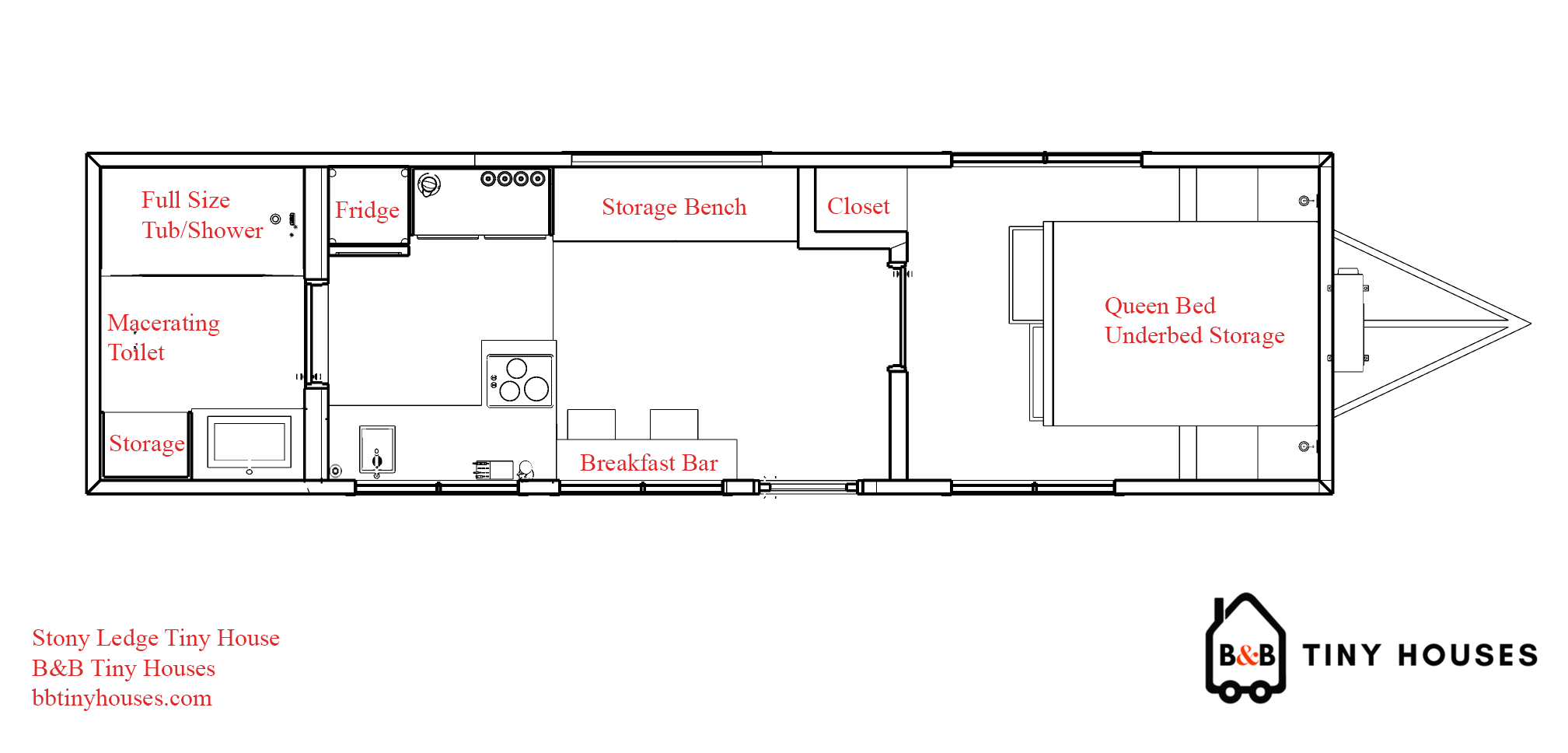
Pictured: Floor Plan of the 8.5′ x 30′ Stony Ledge Tiny House
We’ll start our design session by finding out how you plan to use your tiny house. Will you travel with it? Will it be used as a permanent residence, guest house or vacation home? Do you plan to host visitors? Do you love to cook? Is physical accessibility a priority? We’ll end up designing your house differently according to whether you need water tanks, whether you’ll move your house often, or whether you’ll use solar power, so we like to know up front what your plans are so we can design around them.
Next, we’ll go through all your choices for fixtures, materials, and colors.
After our design session, we’ll spend a week or two creating a quote for you.
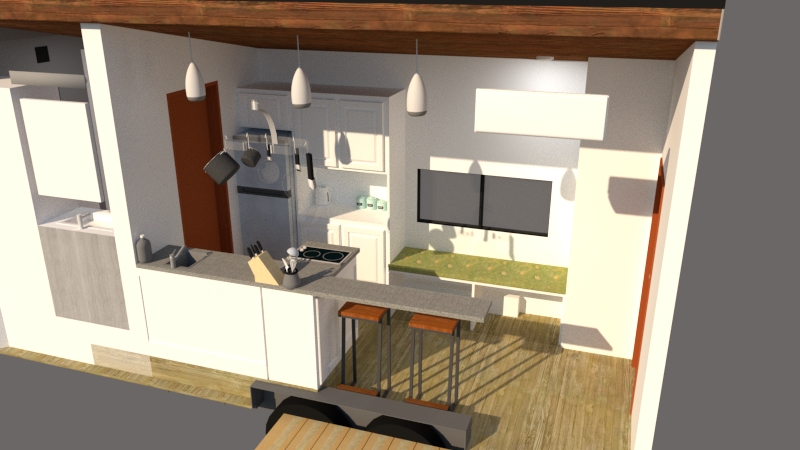
Pictured: Interior rendering of the Stony Ledge Tiny House.
We’ll have another short meeting to answer any questions you may have with your quote. If you’d like to alter it, we will go through the process with you until you’re happy with your quote.
When you’re ready to move forward with having your tiny house built, let us know we’ll send you a construction contract to sign. Once we’ve received your first payment (or, if you’re financing your build, when your financing comes through to us) we’ll be able to start ordering the materials for your house and building it. We’ll keep you updated about the status of your build and scheduling delivery, if needed.
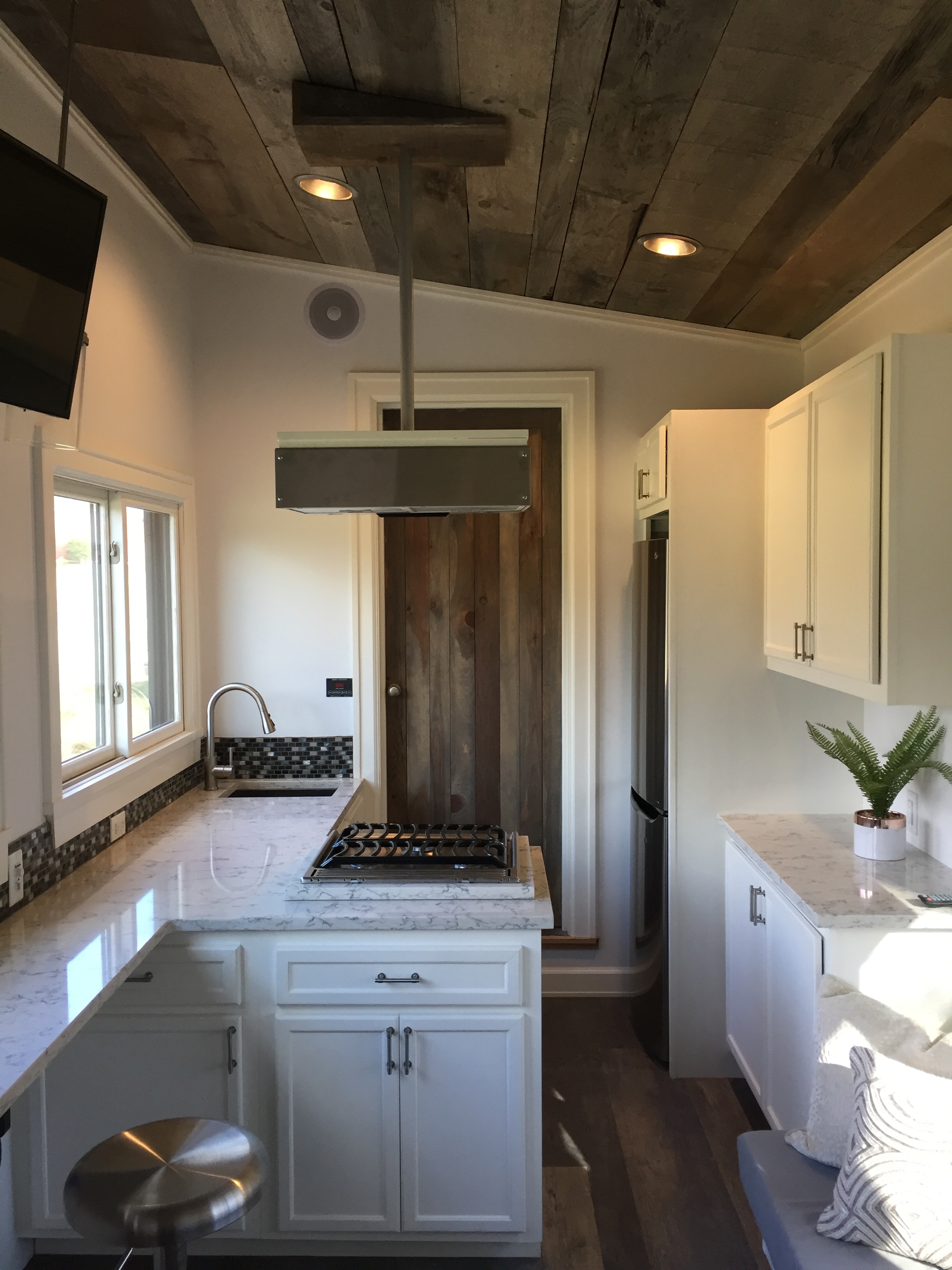
Image: Completed Kitchen in the Stony Ledge Tiny House.
I work in a tiny house. More specifically, a mobile office. Here at B&B, our company has grown faster than our factory has, so now a few of us share the 8 1/2′ x 20′ Brodie Mobile Office for 8 hours a day, 5 days a week. During that time, I’ve learned quite a few things about how to best design a small space for maximum working and living.
Here’s what I’ve learned:
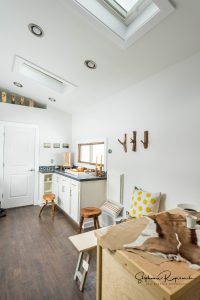 Windows and skylights make a huge difference.
Windows and skylights make a huge difference.Before moving out to the mobile office, I was working inside the factory in a little room we built into the corner of the warehouse. This room had windows to the factory but no windows to the outside. Now that I’m in the mobile office and my desk faces two windows, my quality of life has really improved. The old office, although it was bigger than the mobile office, felt a bit cave-like, and not in the way of grand echoing caverns; it was more like those tiny spaces spelunkers narrated by David Attenborough have to squeeze their bodies into. Anyhow, with its tall ceilings, skylights, and windows all around, the tiny mobile office, although smaller than the old office, feels way more spacious.
Both for air exchange and light, it’s nice to have windows on all sides of you. Opening a window at either side of the house creates a nice breeze. Because you’re surrounded by windows rather than looking at one or two walls with windows, the space feels more expansive and airy than a smaller space.
This goes for any house, not just tiny houses, but it’s something I’ve learned from this particular tiny house so I thought I’d share it here. I can’t stress this enough: choose a floor color that’s not going to show every single piece of dirt, dust, sand, mud, piece of grass, and microscopic pebble. This house was photographed on a day when the snow went up to our knees and we mopped the floor just before the shoot. If we hadn’t, you’d see all kinds of smudges on it.
The absolute best floor for mud-concealment is this grey one with lots of color variation. This house (the Arcadia Tiny House) has been exhibited on rainy, muddy days with hundreds of people (and double that number of boots!) walking through and you couldn’t even tell it was dirty.
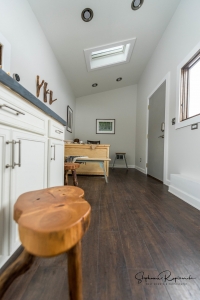
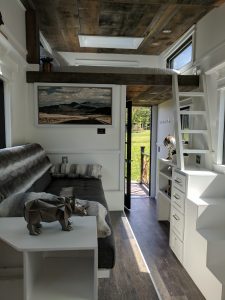
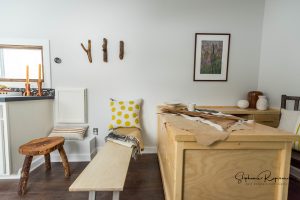 Mobile offices are great for greeting customers outside the work area.
Mobile offices are great for greeting customers outside the work area.Our workshop has six tiny houses being built at a time, with houses, trucks, deliveries, forklifts, et cetera rolling in and out of our factory doors all day. We don’t generally like to invite visitors inside this active work environment simply because it’s too much of a liability. Having the mobile office outside as the face of our company allows us to greet customers in a safe environment, free of sawdust, noise and hazards.
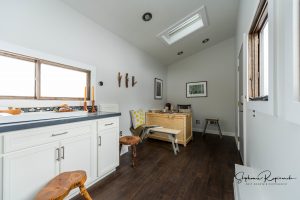 More people can fit in an 8 1/2′ x 20′ space than you think without feeling claustrophobic.
More people can fit in an 8 1/2′ x 20′ space than you think without feeling claustrophobic.We’ve had non-claustrophobic meetings with ten people inside. The level of claustrophobia definitely depends on the amount of stuff inside the house. Since this is an office, not a home, and most of our files are digital, not on paper, we really don’t need that much stuff inside the mobile office. We keep architectural samples, like color chips, siding swatches, and stain samples, but other than that pretty much everything’s digital.
Additionally, the objects that we do have are stored inside the cabinetry so they don’t add to visual clutter.
It’s quiet in the mobile office. Really quiet. It’s a side effect of being well-insulated. So during mealtimes it can be a bit… overwhelming for someone who doesn’t like to hear others chewing. My favorite white noise generator is Celestial White Noise on YouTube. Ten hours of a gentle hum that you tune out after a minute and don’t have to hear every time your coworker shifts in their chair.
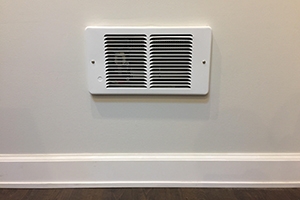
I have hot soup for lunch all the time in the winter. To make sure the mobile office doesn’t then smell like soup for the rest of the day, I always open the restroom door and turn the extractor fan on after eating a hot lunch. It only takes a couple minutes to return the air in the house to freshness.
Certain heating and cooling systems also include air exchange (ours doesn’t)– I’d recommend getting that if possible.
 Tall ceilings and not too much clutter on the walls really make a space feel bigger.
Tall ceilings and not too much clutter on the walls really make a space feel bigger.Perhaps this goes without saying, but I think it’s worth mentioning the tall ceilings inside this tiny mobile office. In order to be road-legal, the tiny house has to be under 13 1/2′ tall so it can fit under bridges, trees and power lines. With the inside floor being just over 2′ off the road, there is still room for a taller-than-usual ceiling inside– and it makes a huge difference!
Tiny living doesn’t mean you have to sacrifice the ability to make delicious home cooked meals. Below are some neat appliances that can make cooking easier and more fun!
These bad boys are able to slow cook, pressure cook, steam, and saute your food. No oven required for delicious meals!

Steamers are easy to clean, healthier as they don’t require oil, allow you to cook all your dinner items at the same time, and require very little supervision.
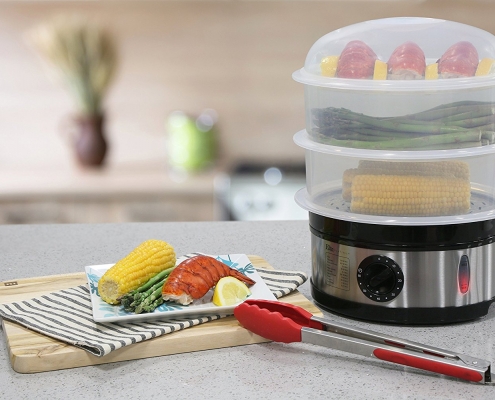
These small egg cookers can serve you poached, scrambled, hard boiled eggs, and omelets in no time. And now time for an egg pun…What does a meditating egg say? Ohmmmmmmmlet.
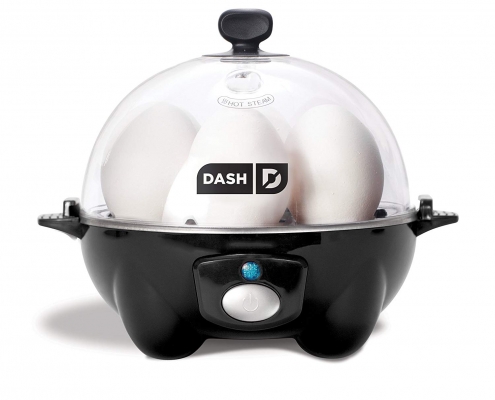 4. Ice Maker
4. Ice MakerThis ice maker can make ice cubes in 6 minutes and will make up to 26 pounds of ice daily.
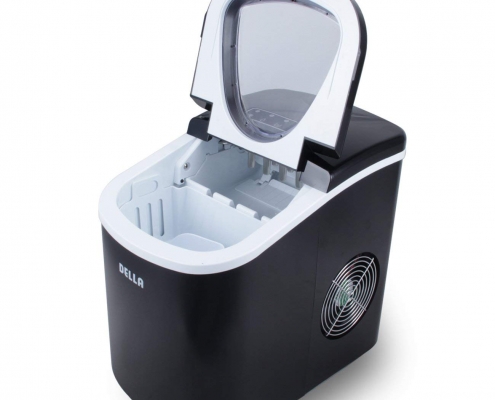
Yummy smoothies are quick and fast with this single serving blender that features one bottle for blending and drinking.
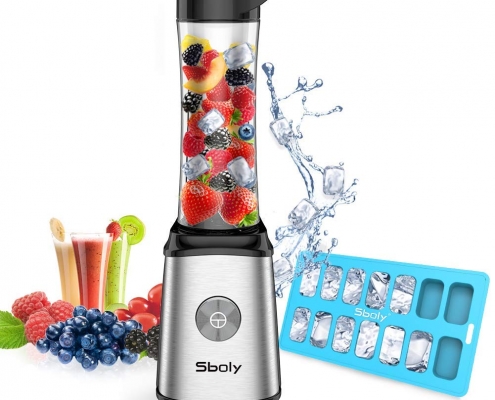 6. 3-in-1 Breakfast Station
6. 3-in-1 Breakfast StationSimultaneously make coffee, pancakes, eggs, toast, and sausage. This is a dream come true!
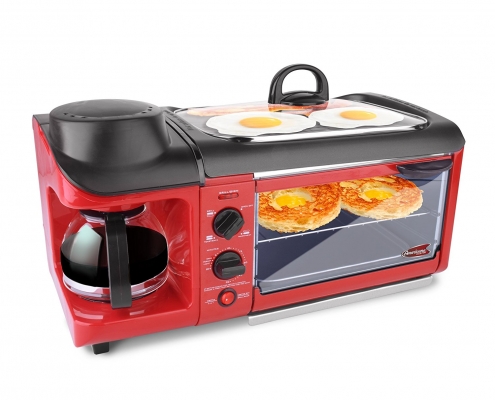 7. Breakfast Sandwich Maker
7. Breakfast Sandwich MakerFinally a fool-proof way to make a circular egg for your breakfast sandwich.
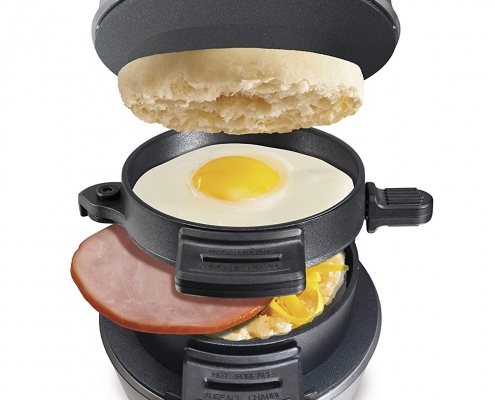 8. Gridler
8. Gridler Bring the grill indoors with this space-efficient appliance.
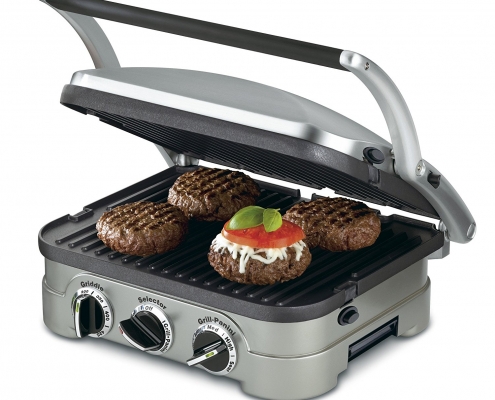 9. Pizza-Maker
9. Pizza-MakerPizza is unarguably the best meal on the planet.
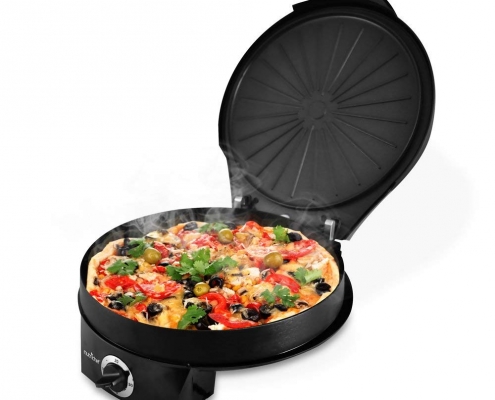
Plant these herbs in pots and put them right below your kitchen window for a green touch and delicious dishes.

At B&B Tiny Houses, we are often asked if a prospective tiny home owner should buy a custom tiny house or choose from our catalog of tiny house designs. Most of our clients will ultimately decide that they want to customize an existing tiny house design for the reasons below.
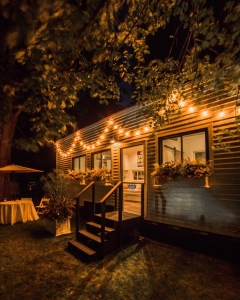
Because we have 9 models of pre-designed tiny houses, most prospective tiny house owners will find a plan that will work for them. With this option, B&B customers will get to choose the finishes on their tiny house for no additional cost. This means that clients will have the option of picking the finishes for the interior and exterior of their tiny home: including the roofing, ceilings, walls, fixtures, and floors. The customization process of the pre-designed tiny homes allows owners to add their own style to their tiny house. The pre-designed tiny houses also allow clients the option of changing the blueprint–i.e. adding an extra closet or rearranging kitchen appliances. Read more about our blueprint changes fee.
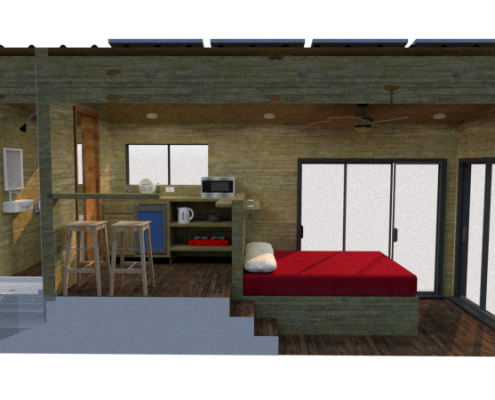
Perfect for weekend vacationers, the Prospect has a beautiful observatory bedroom with large sliding doors on three sides.
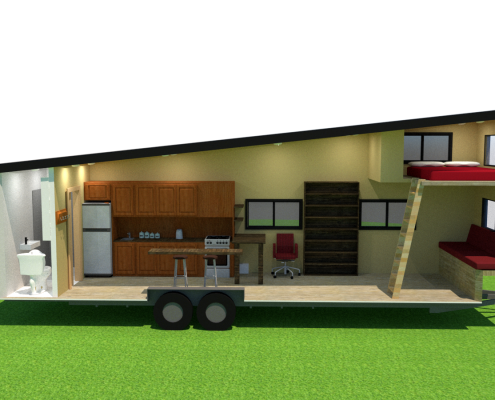
The Sentinel is designed for someone who wants to live tiny but won’t compromise on kitchen space. The kitchen has a full size fridge, oven, and sink, and ample cabinets.
Customers also have the option of working with B&B’s design team to create an entirely original design. Original tiny house designs allow you to create the exact tiny home that you’re envisioning, but due to economies of scale—i.e. custom houses taking longer to build due to the fact that each one is unique and not able to be mass produced— this option can be quite costly. In addition, with a custom house, there is an extra fee to design the sketches of the home and create an estimate. Read more on original tiny house design fees. Custom plans and builds come at a substantial increase in cost and build time, but they also allow those that are willing to pay more to receive a beautiful tiny house designed for their exact needs and lifestyle.
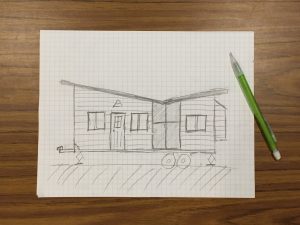
Clients can give our designers sketches of their dream home and see their ideas come to life.
Ready to begin your tiny house buying process? Fill out the form below to get in touch with us.
Composting toilets are the best option for those wishing to live sustainability and off-grid. Composting toilets will cost more upfront and will require additional steps; however, they also save water, energy, and waste can be recycled as fertilizer.
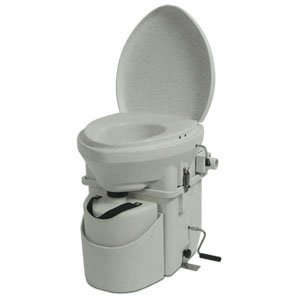
Good quality composting toilets are relatively odorless. Most of the toilets will have a fan that works to suck out any odor that would emit from the toilet. The toilets usually work by separating liquid and solid waste. Solid waste will go into one chamber that will be mixed with peat moss in order to help break the waste down. If you are staying somewhere where composting is not allowed, you will bag the solid waste in a biodegradable plastic bag and throw it away–much like a baby’s diaper is thrown away. Otherwise, you will be able to use the solid waste as compost. The liquid waste will be stored in a tank that will need to be disposed when it’s full. You can dispose the liquid waste in toilets, RV dump stations, or the ground if you are in a remote place where that is allowed. You will have to dispose of waste every 3-7 days for liquid waste and every 2-4 weeks for solid waste.
We have previously written about other types of toilets in one of our previous blog posts. Three other types of toilets in tiny houses are traditional, macerating, incinerating and dry-flush toilets.
Traditional toilets that are used in houses can be used in tiny houses; however, traditional toilets can’t be used with tanks. This means that your tiny house must be permanently in-place and hooked up to septic or sewer system in order to use a traditional toilet.
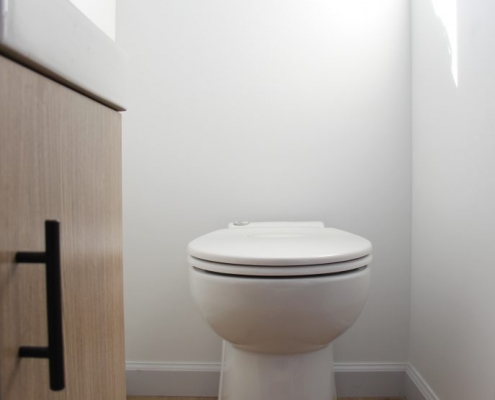
Dry flush toilets are lined with foil which, when “flushed”, wraps around the waste in a sealed packet, similar to a diaper genie. The packaged waste can then be thrown out in any trash can just like diapers. The flushing mechanism is also powered by electricity. For more information on these and our other types of tiny house toilets, read our previous blog post.
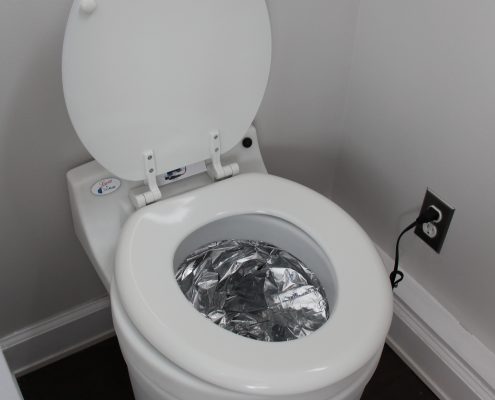
Many tiny home owners chose to adopt the minimalist lifestyle in order to live more sustainably. Solar panels offer a great form of renewable energy, but there are many considerations that you will need to keep in mind before you decide if solar power is the right option for you. In this post, we will talk about the differences between grid-tied and off-grid solar power.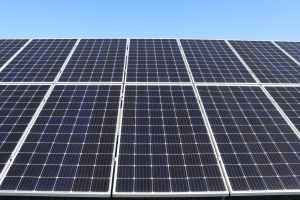
As the name suggests, grid-tied solar systems connect to a utility power grid.
Pros
– Net metering: Net metering is when excess energy created by your solar panels is sent to the utility power grid for others to use. This allows solar panel owners to be paid for the excess electricity that their panels create.
– On-grid Connectivity: If the solar panels do not create enough power for your tiny home, then the electrical grid will give electricity to your home as needed. This can allow a tiny home owner to buy solar panels in phases and increase the amount of panels their home relies on whenever the owner pleases.
– Affordability: Grid-tied solar power is the cheapest option for solar energy.
Cons
– Lack of Transportability: Many tiny home owners like to frequently move around with their tiny house. Because of this, a grid-tied system would not be the ideal choice because they might not have access to an electrical meter while on the move.
Off-grid systems are able to move with tiny home owners as they travel. Off-grid systems work by converting sunlight to power during the day and then storing this power in batteries for future use.
Pros
– Transportability: With this option, you are able to travel with your tiny home and have a source of power.
– On-grid connect-ability: There are off-grid options that can also connect to the grid, which enables tiny home owners to not have to worry about not having electricity and allows owners to sell back surplus electricity.
Cons
– Price: Compared to grid-tied systems, off-grid systems cost more money. In order to prevent a lack of power, most off-grid systems are oversized to make sure that there are no outages; this usually takes into consideration 1-2 days without solar panel generation.
– Lack of Electricity: Solar panels may not produce enough electricity due to weather or because your tiny home is using more power than predicted. As discussed above, this is why most off-grid systems are oversized. Tiny home owners do have the option of charging the batteries via a generator if there is not enough solar power produced.
Depending on how you are wanting to use your tiny home and budget will probably be most tiny home owners’ biggest considerations when deciding which solar system to opt for.
We are often asked about how we calculate square feet in our tiny homes. This is a great question as there is no regulation regarding calculating square feet–this is true even in traditional homes. Rather, there is an accepted code that the industry follows. Other competitors do not always follow the same code that we at B&B use when calculating square feet, which can make comparing tiny homes confusing.
Pictured: the Hoosic Tiny House
Let’s dive into some of the different criteria for what spaces must meet. We use the International Building Code, specifically Building Code Appendix Q, which describes the code for tiny houses on foundations. Although much of what B&B Tiny Houses builds are tiny houses on wheels, we use the international building code as a guide for calculating square footage.
From IBC Appendix Q:
Minimum ceiling height: habitable space must be over 6 feet and 8 inches with the exception of bathrooms and kitchens which must be over 6 feet and 4 inches
Loft: located at least 30 inches above the main floor, is open to the main floor, and used as a living or sleeping space
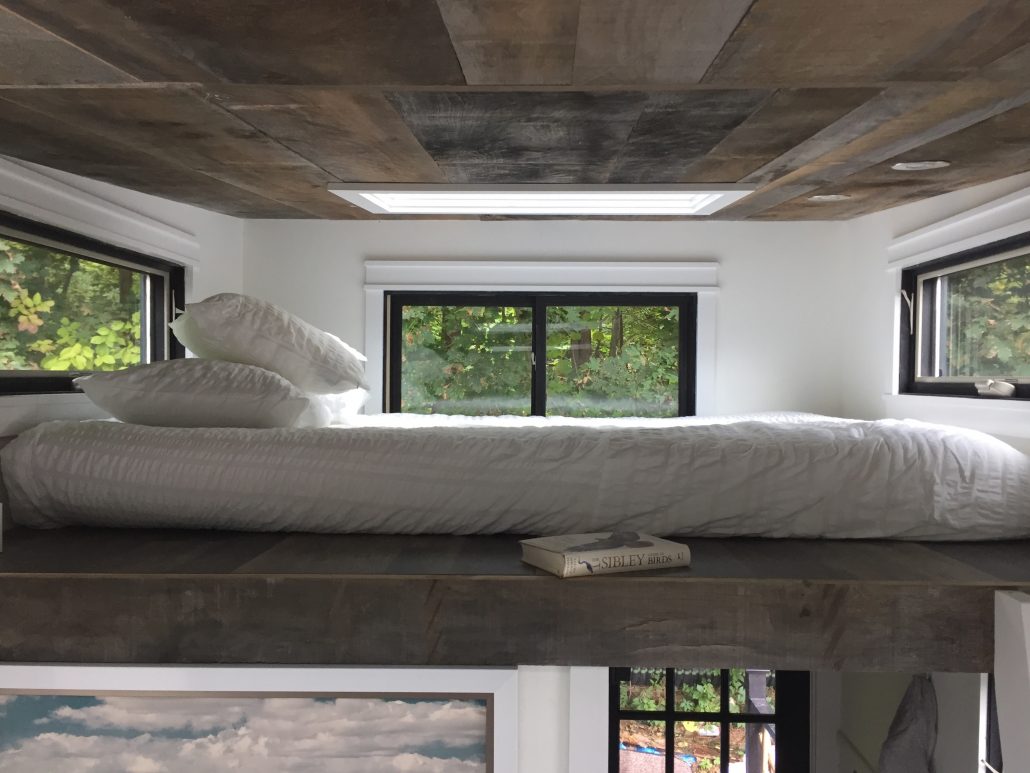
Pictured: The Arcadia Tiny House
Tiny houses on wheels, in order to be road-legal, must be 13 1/2′ off the ground in order to fit under bridges. Therefore, it would be impossible or a tiny house to have a loft one can stand up in. Because lofts in tiny houses on wheels do not meet the minimum ceiling height to be considered “habitable” space in the building code, they should not be included in a tiny home’s square footage.
To calculate the square footage, multiply the inside width and length of the tiny house. Almost all of B&B’s tiny houses on wheels are the road-legal maximum width of 8 1/2′; their length varies. The exterior walls of our tiny homes (unless otherwise specified) are 6 inches thick on each side and end. To calculate the square footage of the Stony Ledge which has outside dimensions of 8 1/2′ x 30′, we multiply 7 1/2′ x 29′ to get 217 1/2 square feet. The Arcadia, which has a loft, has a square footage of 142 1/2 plus a 45 square foot loft.
When shopping for tiny homes, you should always check how the square feet has been calculated. Otherwise, it can be like comparing apples and oranges. If you are interested in learning more about the square feet in tiny homes, read this post about why tiny homes cost more per square feet than traditional homes.
You’ve got many different options when it comes to picking out which type of AC and heating system you would like. When deciding which system to choose, it’s important to note factors like the climate, specific use, location, ease of convenience, and cost. All tiny home owners should make sure a professional installs or checks their HVAC systems, so that you can ensure your tiny home is a healthy environment to live in.
In wall electric heaters and air conditioners are a popular choice for your tiny home. They are relatively cheap and will get the job done. Some tiny owners may choose another option, however, due to the fact that they take up precious space that could otherwise be utilized in your tiny home. In addition an in wall system, because it takes up a significant amount of space, can affect the overall aesthetic of your tiny home.

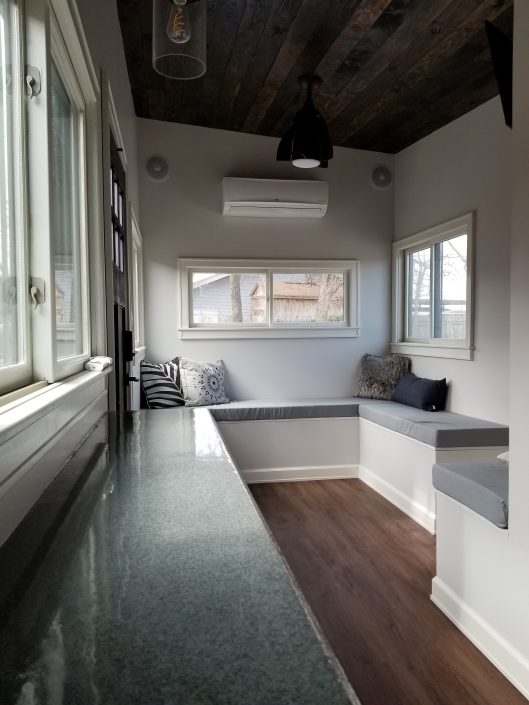
Mini-splits are the ideal choice for most tiny home owners. Mini-splits function like traditional homes’ HVAC systems in that the condenser is placed outside the home and the fan is placed inside the home. The obvious benefit to this is that it frees up space in your tiny home and becomes less of an eye sore when compared to a window or in wall heater. Mini-split units are also very energy efficient. Read more about finding the most efficient heating and AC units. Although these systems are more energy efficient, they require a higher cost upfront.
Window air conditioning units are a cheaper option than in wall or mini-split heaters and can be easier to install. There are many energy efficient options on the market, which can help lower your monthly utilities bills. One drawback to this option is that it will be an even bigger eye sore than in wall systems because they will not blend in with your tiny home.
If you are only going to be living in your tiny home during a particular season or live in mild climates, you may be thinking about using fans or plug-in electric heaters in your tiny home. With this option as your only source of heating or cooling, you may run into problems with moisture and ventilation. If there is excessive moisture, then you can run into problems with mold. Click here for more about the health considerations about indoor air quality.
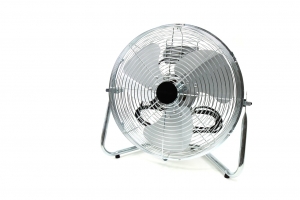
Learn more about our process or fill out the form below and one of our tiny house experts will reach out to you.
